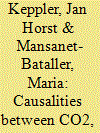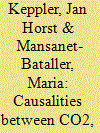| Srl | Item |
| 1 |
ID:
096643


|
|
|
|
|
| Publication |
2010.
|
| Summary/Abstract |
The topic of this article is the analysis of the interplay between daily carbon, electricity and gas price data with the European Union Emission Trading System (EU ETS) for CO2 emissions. In a first step we have performed Granger causality tests for Phase I of the EU ETS (January 2005 until December 2007) and the first year of Phase II of the EU ETS (2008). The analysis includes both spot and forward markets-given the close interactions between the two sets of markets. The results show that during Phase I coal and gas prices, through the clean dark and spark spread, impacted CO2 futures prices, which in return Granger caused electricity prices. During the first year of the Phase II, the short-run rent capture theory (in which electricity prices Granger cause CO2 prices) prevailed. On the basis of the qualitative results of the Granger causality tests we obtained the formulation testable equations for quantitative analysis. Standard OLS regressions yielded statistically robust and theoretically coherent results.
|
|
|
|
|
|
|
|
|
|
|
|
|
|
|
|
| 2 |
ID:
097477


|
|
|
|
|
| Publication |
2010.
|
| Summary/Abstract |
The topic of this article is the analysis of the interplay between daily carbon, electricity and gas price data with the European Union Emission Trading System (EU ETS) for CO2 emissions. In a first step we have performed Granger causality tests for Phase I of the EU ETS (January 2005 until December 2007) and the first year of Phase II of the EU ETS (2008). The analysis includes both spot and forward markets-given the close interactions between the two sets of markets. The results show that during Phase I coal and gas prices, through the clean dark and spark spread, impacted CO2 futures prices, which in return Granger caused electricity prices. During the first year of the Phase II, the short-run rent capture theory (in which electricity prices Granger cause CO2 prices) prevailed. On the basis of the qualitative results of the Granger causality tests we obtained the formulation testable equations for quantitative analysis. Standard OLS regressions yielded statistically robust and theoretically coherent results.
|
|
|
|
|
|
|
|
|
|
|
|
|
|
|
|
| 3 |
ID:
097275


|
|
|
|
|
| Publication |
2010.
|
| Summary/Abstract |
The European Union Emissions Trading Scheme (EU ETS) has imposed a price on the allowances for CO2 emissions of electricity companies. Integrating this allowance price into the price of electricity earns a rent for companies who have received these allowances for free. During Phase I, 2005-2007, rents corresponding to the aggregate value of allocated allowances amounted to roughly € 13 billion per year. However, due to the specific price-setting mechanism in electricity markets true rents were considerably higher. This is due to the fact that companies also that have not received any allowances gain additional infra-marginal rents to the extent that their variable costs are below the new market price after inclusion of the allowance price. Producers with low carbon emissions and low marginal costs thus also benefit substantially from carbon pricing. This paper develops a methodology to determine the specific interaction of the imposition of such a CO2 constraint and the price-setting mechanism in the electricity sector under the assumption of marginal cost pricing in a liberalized European electricity market. The article thus provides an empirical estimate of the true total rents of power producers during Phase I of the EU-ETS (2005-2007). The EU ETS generated in Phase I additional rents in excess of € 19 billion per year for electricity producers. These transfers are distributed very unevenly between different electricity producers. In a second step, the paper assesses the impact of switching from free allocation to an auctioning of allowances in 2013. We show that such a switch to auctioning will continue to create additional infra-marginal rents for certain producers and will leave the electricity sector as a whole better off than before the introduction of the EU ETS.
|
|
|
|
|
|
|
|
|
|
|
|
|
|
|
|
| 4 |
ID:
187592


|
|
|
|
|
| Summary/Abstract |
Deep decarbonization of energy systems poses considerable challenges to electricity markets and there is a growing consensus that an energy-only design based on short-term marginal cost pricing cannot deliver adequate levels of investment and long-term coordination across actors and sectors. Based on the instructive example of the evolution of European electricity market designs, we discuss several shortcomings of energy-only markets and illustrate how ad-hoc policies that intend to address them have limitations of their own, notably a lack of systemwide coordination. Second, we describe how the sheer scale and nature of deep decarbonization targets requiring massive investment in capital-intensive low-carbon technologies exacerbate these issues. Ambitious emission reduction targets thus require an evolution of market design towards hybrid regimes. Hybrid markets separate long-term investment decisions from short-term operations through a balanced and differentiated use of competitive and regulatory design elements to coordinate and de-risk investment. Finally, a historical analysis of the evolution of different electricity market designs shows how hybrid markets constitute contemporary forms of long-run marginal cost pricing that are appropriate for meeting deep decarbonization targets with reduced uncertainty and hence lower private and social costs.
|
|
|
|
|
|
|
|
|
|
|
|
|
|
|
|